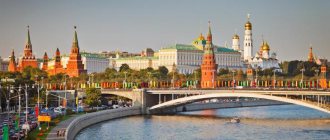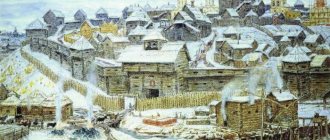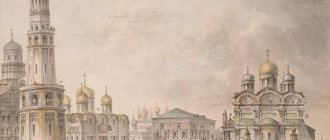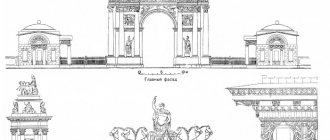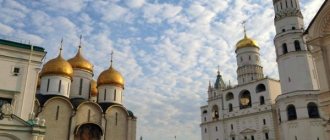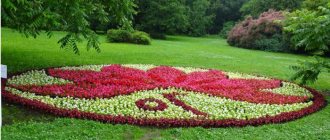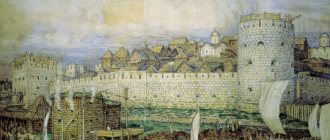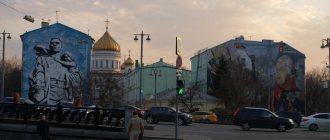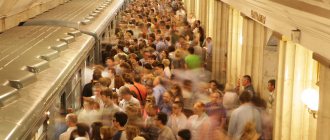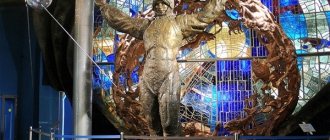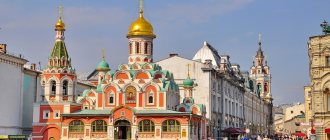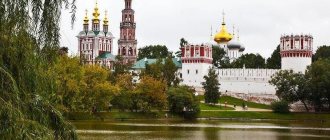History of the construction of the cathedral
In 1326, the first Assumption Cathedral was founded in the Kremlin under Ivan Kalita - a modest one-domed temple . In 1337, after a major fire, the Assumption Cathedral no longer corresponded to the new status of Moscow as the capital of All Rus'. Prince Ivan III and Metropolitan Philip decided to build a majestic cathedral on the site of the old one, worthy of becoming the spiritual center of the state.
The whole world was building a new cathedral: they announced a fundraiser. Boyars, merchants and other laymen collected donations, and all monasteries were taxed. Russian architects Kravtsov and Myshkin built the cathedral up to the vaults, but in May 1474, during an earthquake, the nearly completed cathedral collapsed.
To build a new cathedral, Prince Ivan III turned to Italian architects. The famous architect and engineer from Bologna, Aristotle Fioravanti, responded to the invitation.
In his homeland, the architect enjoyed fame. Under his leadership, for the first time in the world, a 24-meter-high bell tower, which was interfering with the construction of the administration building, was moved to another place in 2 days. The City Council of Bologna, appreciating the master’s merits, assigned him a generous lifelong security.
The architect's comfortable life was disrupted by the machinations of envious people: Fioravanti was thrown into prison following a denunciation, deprived of his privileges. It soon became clear that the accusation was false, but resentment prompted Fioravanti to accept the invitation of the Russian Tsar, and the architect left Italy forever.
Assumption Cathedral in Moscow on the map
- Tours to Turkey for 9 nights, 5* party hotels, all inclusive from RUB 104,916 for TWO – September
- Miami Attractions
- Tours to Tunisia for 9-12 nights, 2 adults + 1 child, 4-5* hotels, all inclusive from 82,608 rubles for THREE – August
- What to see in Beijing: itinerary for 7 days
- Tours to the island Hainan (China) for 8 nights, 4 and 5* hotels, breakfasts from RUB 75,487 for TWO – September
- Vatican Library – what is it hiding?
- Sights of The Hague
- Piazza Navona in Rome
- Hotels in Turkey with a large territory
- Barcelona 4 star hotels in the center
- Croatia hotels with water park and water slides
- The most expensive hotels in Crimea
0
Aristotle Fioravanti - architect of the Assumption Cathedral of the Kremlin
In the summer of 1745, the foundation of the new cathedral was laid. The construction of the temple amazed Muscovites with its speed and new methods of work, never before used in Rus'. By order of the architect, the first brick factory was built in Moscow: the construction needed bricks. To secure the foundation, oak piles were driven into the ground to a depth of 5 meters. The walls, built in 2 bricks, are reinforced inside with metal bands.
The walls of the white-stone, five-domed cathedral, covered with cross vaults, were built from hewn blocks of stone. The six pillars inside the cathedral space, the vaults and the drums were made of brick, lined with white stone. To strengthen the walls, the architect used iron piles and lime, strong as stone.
During construction, the architect took into account the mistakes of his predecessors and carefully checked and calculated everything. The temple, built 4 years later, amazed contemporaries with its size and richness of interior decoration.
Aristotle Fioravanti
The Assumption Cathedral in the Moscow Kremlin was erected in 1479 in order to consolidate the political structure and develop state rituals. The history of its construction is dramatic.
At first, the task of erecting a huge temple was entrusted to domestic (Pskov) craftsmen. However, they did not cope with the job. The nearly completed cathedral collapsed.
Ivan had no intention of entrusting the construction to his compatriots anymore. The Italians were called.
We must understand that at the time when the Assumption Cathedral in the Moscow Kremlin was being built, the architects of the Italian Renaissance were ahead of the rest. Thanks to the active work of diplomats from northern Italy, Rudolfo Fioravanti was called to the Mother See.
He built the Assumption Cathedral in the Moscow Kremlin.
During his lifetime, the architect was nicknamed Aristotle for his learning. However, he was, first of all, not an architect, but an engineer and builder, and his experience should have served as insurance against those possible mistakes that Pskov craftsmen had made in previous years.
Aristotle shocked Muscovites with his advanced approach to construction problems. Instead of immediately laying stone on stone and fastening them with lime, he first drew up a detailed drawing of the future cathedral on paper.
Then he found suitable clay in the vicinity of Moscow, built a factory for the production of bricks, in order to begin construction with standardized blocks capable of holding a certain weight.
By the way, he had his own theory why the previous cathedral collapsed - it was simply too big.
Fioravanti had it all figured out. Mathematics. And this approach of the Renaissance man amazed Moscow contemporaries, because they had never before seen an architect behave like a scientist.
It is important to understand how the city began to change with the arrival of the Italians. The Kremlin itself was much smaller before that. The buildings are mostly wooden. Even the Grand Duke's tower was made of wood. And here and there stood small stone churches. In general, Moscow was, according to Western European standards, closer to a village than to a city.
By the way, the expression “Moscow is a big village” arose only when the first foreigners began to come to us.
The Italian architect treated the Russian Orthodox tradition with great tact. Before building in Moscow, he went to Vladimir to inspect the Assumption Cathedral there, built in the 12th century. That is, he created precisely an Orthodox church, and did not blindly transfer the Italian style to Russian soil.
Thus, the Assumption Cathedral of the Moscow Kremlin appeared on the territory of the Moscow Kremlin thanks to the skill of the famous Italian.
Architectural styles and exterior design
In the creation of the architect Fioravanti, one can feel the influences of Byzantine and Romanesque, Gothic and Old Russian art. The building, made of blocks, looks monolithic, like “one stone.” hall-type temple with six thin round pillars, spaced very widely, surprises with its “majesty and height, and lightness, and space.”
The elongated western part makes the cathedral more spacious. Spaciousness and abundance of light are a distinctive feature of the Assumption Cathedral. The light pouring from the drum windows and round windows in the walls creates a feeling of spaciousness and celebration.
The facade of the cathedral consists of piers - spindles, delimited by blades. The building is divided horizontally by a decorative belt of small columns and arches, and vertically by pilasters with narrow windows, creating a feeling of lightness of the structure. The cathedral is crowned with five chapters - the symbol of Jesus Christ and the four evangelists: Matthew, Luke, Mark and John. The central head of the temple is taller than the others and larger in size.
Under the shadow of the Assumption Cathedral
The cathedral retained its high status even after the capital of the Russian Empire was moved to St. Petersburg in the 18th century.
Famous paintings
The cathedral is famous for its paintings, which appeared during the time of Mikhail Romanov in the 17th century. Golden light emanates from the vaults and walls, which gave the process of ascension of the sovereigns to the throne a kind of divine approval.
The icon painter Dionysius and his students were invited to paint the Assumption Cathedral. 150 artists, led by royal masters, created cycles of paintings. On the southern facade there is an image of Our Lady of Vladimir with the archangels Michael and Gabriel.
The tier below is 6 saints, Moscow and Rostov metropolitans. Here, under the window, is the image of the Savior Not Made by Hands. At the top of the walls are illustrations of the Gospel. On the western side is the composition “The Last Judgment”. On the round pillars are numerous figures of martyrs. On the vaults and walls of the temple there are 249 subject compositions and 2066 individual figures.
On the north side there are images of Paphnutius Borovsky, Isaiah, Leonty and Ignatius of Rostov, Sergei of Radonezh. Above them is the composition “Cathedral of the Apostles” with the image of Christ, the Mother of God, John the Baptist and the 12 apostles. In the center of the eastern wall is the New Testament Trinity: God the Father, God the Son and the Holy Spirit in the form of a dove. On the vaults there are compositions on gospel themes: “The Presentation of the Virgin Mary into the Temple.” "The Birth of Christ". "The Presentation of the Lord."
In the temple there is a silver chandelier with colored garlands weighing 328 kg, cast in memory of the victory over Napoleon. There is also an openwork tent for storing church relics. In the center of the cathedral there are three crosses, on which, on either side of Christ, crucified thieves and the figures of two angels are depicted.
Iconostasis
The temple has a rich collection of icons. The icons of the cathedral are in rich frames made of pure gold , and all the utensils are made of silver. The mighty 16-meter iconostasis, stretching under the arches, was created in 1654 by order of Patriarch Nikon. The 69 icons placed here represent events from biblical history. Five tiers of the iconostasis, decorated with gilding, add solemn splendor to the hall church. In the forefathers' rank - an icon of the Holy Trinity. The forefathers are depicted in full growth, with scrolls in their hands. The prophetic tier includes 17 icons.
The festive series includes images that the church annually celebrates: the Birth of the Mother of God, the Annunciation of the Blessed Virgin Mary, Baptism, the Entry of the Lord into Jerusalem, the Dormition of the Blessed Virgin Mary. In the Deesis rite we see the prayerful presence of the saints at the Last Judgment before Christ the Pantocrator, the twelve apostles and the icon “Savior Pantocrator”.
On the royal doors are the Mother of God, the Archangel Gabriel and 4 evangelists: Mark, Luke, John, Matthew. To the left of the royal gates, in a special icon case, is the greatest shrine of Ancient Rus' - the icon of the Vladimir Mother of God, patroness and intercessor of the Russian land. To the right of the royal gates is the image of the Savior on the throne “The Golden Rose of the Savior.” This is a Byzantine icon from the 11th century.
A huge iconostasis occupies a wide wall. In front of him are prayer places: the royal one is at the left pillar. True, kings and queens never stood here. At the right pillar is the patriarchal seat. The third is the grand-ducal seat, the Monomakh throne, made of walnut wood in 1551 for Ivan the Terrible.
The six-meter tent, decorated with images of flowers and birds, rests on the figures of four animals with flattened ears and bared teeth. The octagonal dome is topped with a double-headed eagle. The frieze is covered with inscriptions from the Holy Scriptures.
In the right corner of the cathedral, near the iconostasis, is the shrine of St. Philip. In 1568, Metropolitan Philip Kolychev here publicly accused Ivan the Terrible of atrocities, for which he paid with his life. By order of the enraged ruler, the metropolitan was strangled.
mural painting
The best masters were hired to paint the first altar church. The oldest frescoes of the Moscow Kremlin are preserved on the altar barrier - images of ascetic monks, painted in 1481 by the artel of the great icon painter Dionysius. Altar compositions of the same time are also known - “The Seven Sleeping Youths of Ephesus”, “The Forty Martyrs of Sebaste”, “The Adoration of the Magi” and others. Then the Assumption Cathedral was painted in 1513-1515. In 1642-1643, this painting was knocked down with plaster, having previously removed the “translations”, and a team of 150 artists led by the royal isographers Ivan and Boris Paisein and Sidor Pospeev completed the existing mural.
The architecture and murals of the temple create an image of space, where the vaults symbolize the sky carried by the pillars of the cathedral. As a rule, images of martyrs are placed on the pillars, who support the Church with their lives and martyrdom, just as the pillars support the arch.
The painting of the Assumption Cathedral is distinguished by thoughtfulness and clarity of construction. The chapters contain various images of God, the upper parts of the walls are occupied by illustrations of the Gospel, their arrangement corresponds to the sequence of services throughout the year. The painting on the second tier from the top on the southern and northern walls tells the story of the miraculous birth of the Virgin Mary and Her childhood. The next row is occupied by illustrations of the Akathist in honor of the Mother of God. An interesting feature of the painting is the image of the seven Ecumenical Councils in the lower tiers of the walls. On the western wall of the temple there is traditionally a huge composition of the Last Judgment. Numerous figures of martyrs are painted on the round pillars.
Place of the most important state events
The main celebrations took place under the arches of the Assumption Cathedral - the crowning of Russian sovereigns. Members of the royal family entered through the copper gate, made using the technique of gold guidance, on which 20 biblical images were applied in gold. The vaults of the Assumption Cathedral bear witness to how the sobbing 16-year-old Mikhail Romanov entered here.
The young heir was afraid of the responsibility that had fallen on him. After the Time of Troubles - a period of bloody strife and vile betrayals, the new sovereign had to raise Russia. Royal wedding ceremonies became grandiose events in the life of the country. 21 Russian rulers were crowned in the Assumption Cathedral.
The weddings of sovereigns took place in the Assumption Cathedral . Alexey Mikhailovich was the first among the Romanovs to begin baptizing children here. In June 1744, Catherine II converted to Orthodoxy here. Under the arches of the cathedral they celebrated the fall of the Horde yoke, the conquest of Kazan, the victory in the Northern War and over Turkey.
In 1812, during the occupation of Moscow, the French removed the vestments from the icons and melted them down, turning them into 5.3 tons of silver and 290 kg of gold. Some of the jewelry was saved, but the French took the bulk with them. Leaving the Kremlin, Napoleon ordered the Assumption Cathedral to be blown up, but the ignited wicks were miraculously extinguished by suddenly gushing rain. On April 23, 1814, in the Assumption Cathedral, a “song of praise to the Lord” was sung in honor of the capture of Paris and the deposition of Napoleon.
Here, in the Assumption Cathedral, in 1903, the act of excommunication of Leo Tolstoy from the church was read. In March 1918, the new government seized 65 pounds of silver from the Assumption Cathedral, and the icons were sent to the State Tretyakov Gallery. According to legend, in the winter of 1941, when the Nazis stood near Moscow, Stalin ordered a prayer service to be secretly served in the Assumption Cathedral for the salvation of the country from the invasion of foreigners.
Since 1382, metropolitans and patriarchs have been buried in the Assumption Cathedral; there are 20 tombs . Most of the burials are under the floor and are marked by low rectangular monuments with flat lids. The tradition of burials in the Assumption Cathedral began with the burial here of its founder, St. Metropolitan Peter.
The last patriarch of the Peter I era, Adrian, “the Tsar’s confidant,” is buried on the western side. The tombstones of the patriarchs are in carved white stone slabs with epitaphs. Next to the patriarchal tombs is the Holy Sepulcher, where the staff of Metropolitan Peter and the Nail of the Lord, which was used to nail Jesus Christ to the cross, are kept.
Story
Assumption Cathedral of Ivan Kalita, XIV century. Reconstruction of Sergei Zagraevsky
Construction
The first Assumption Cathedral in Moscow was founded on August 4, 1326 under Ivan Kalita, and consecrated on August 14, 1327[3]. It was founded by Metropolitan Peter of Kiev and All Rus', who moved his throne from Vladimir to Moscow. Initially, it was a single-domed white-stone three-apse temple, crowned with kokoshniks, to which chapels were later added[1][4]. In style, it resembled the Vladimir-Suzdal buildings of the early 13th century, in particular the St. George Cathedral in Yuryev-Polsky. The temple was built using a technique characteristic of that time: masonry from roughly processed squares of white stone was combined with smooth-hewn elements of architectural decor [5][6][7][8]. The icon “Our Lady Hodegetria, with festivals in the fields”, brought from Byzantium, was kept in the cathedral[9].
During a major fire in 1470 that raged in the Kremlin, the northern aisle of the temple - the Church of the Adoration of the Apostle Peter - collapsed, the vaults cracked, after which they were strengthened with massive logs. The initiator of the renovation of the cathedral was Metropolitan Philip of All Rus'. The reason for perestroika was also the change in the status of Moscow, which became the political and spiritual center of the Russian state. To raise funds, all monasteries were taxed, and laymen and clergy were encouraged to donate. The project was entrusted to the Pskov masters Krivtsov and Myshkin, the work was supervised by Vladimir Grigorievich and Ivan Vladimirovich Khovrin, as well as Vasily Ermolin. In 1472, the solemn ceremony of laying the foundation of the temple took place. The Assumption Cathedral in Vladimir was chosen as a model for construction. A temporary wooden church was built inside the building, in which Ivan III married Sophia Paleologus[10][7][11].
The construction that began was not completed: the temple, built to the vaults, collapsed after the “coward” earthquake that occurred in Moscow on May 20, 1474. The chronicler testifies:
...there was a coward in the city of Moscow and the church of St. The Mother of God, it was already done to the upper chambers, falling at 1 o’clock in the morning, and the temples all shook, just as the earth shook[12].
Researchers cite insufficient strength of the mortar and thin side walls as the cause of the destruction[10][13]. To complete the construction, the Italian architect Aristotle Fioravanti was invited to Moscow. According to his design, the cathedral was built from hewn blocks of white stone and brick, which were used to line the pillars, vaults and drums of the domes. To strengthen the walls, iron piles were laid in them. The facades were divided into vertical projections. The temple was consecrated on August 12, 1479 by Metropolitan Gerontius[14][15]. In 1481, the cathedral was painted by the icon painter Dionysius and his students[16]. Sergei Zagraevsky points out a peculiarity of the architect’s engineering concept: the bricks were built into the masonry in such a way that the building as a whole retained its white stone appearance[17].
XVI-XIX centuries
Assumption Cathedral in the 19th century. Painting by Henry Charles Brewer
View from the south side, 1883
During the restoration after the fire of 1547, the top of the temple was covered with gilded copper sheets, and the relics of Metropolitan Peter were transferred from a silver shrine to a gold one. In 1561, four ancient images were brought from Veliky Novgorod and placed in the Assumption Cathedral: “The Savior on the Throne (Savior’s Golden Robe)”, “Apostles Peter and Paul”, “Ustyug Annunciation” and “Our Lady Hodegetria”[18][19] .
In 1624, the vaults, which were in danger of falling, were dismantled and rebuilt again with additional reinforcement with cohesive iron and the introduction of girth arches. Four years later, there was a fire in the cathedral, after which it was overhauled. The vaults and drums were again strengthened, the white stone archivolts were removed and replaced with brick ones. To protect the spinning wheels from rain, canopies made of roofing iron were installed over them[19]. In 1625, the Robe of the Lord, sent as a gift to Tsar Mikhail Fedorovich by the Persian Shah Abbas I, was transferred to the cathedral. In honor of this event, the holiday “Position of the Robe of the Lord” was established. The precious ark with the robe was placed in a bronze tent for storing sacred relics[20].
In 1642-1644, the cathedral was painted anew according to the 1515 models. To this day, fragments of the original murals have been preserved, which is the oldest example of fresco painting on the territory of the Kremlin. Among the masters were Ivan and Boris Paisein, Sidor Osipov Pospeev, Mark Matveev, Bazhen Savin, Stepan Efemov, icon painters and banner makers from Vladimir, Novgorod, Kostroma and other cities[21]. They wrote 249 subject compositions and 2066 individual figures[22]. In the 1660s, the painting of the external walls was updated: above the altars, above the northern and western doors[23]. In the second half of the 17th century, the Pokhvalsky chapel, in which services were held only on the patronal feast, was moved to the southeastern chapter. By this time, the cathedral owned 160 courtyards, and by the 70s - 253[2].
The Trinity Fire of 1737 damaged the cathedral's paintings and the integrity of the walls. The renovation work was carried out during the reign of Elizabeth Petrovna under the leadership of the architect Ivan Michurin. Restoration of the paintings began in 1767[24]. In 1775, by order of Prince Grigory Potemkin, icons from the Armory were transferred to the cathedral, which were placed in iconostases near the northern and southern walls. In the 1790s they were covered with gold and silver frames[25]. In 1797, the Act of Succession to the Throne issued by Paul I, which repealed the decree of Peter I of 1722, was transferred to the cathedral for safekeeping[26].
During the occupation of Moscow by the French in 1812, the Vladimir Icon of the Mother of God, the Robe of the Lord, Korsun crosses and other valuables were taken from the cathedral. Among the tombs of the saints, only the shrine of Metropolitan Jonah survived. Horse stalls were installed in the temple premises. The robes from the icons were melted down into 5.3 tons of silver and 290 kg of gold. Some of the metal was returned during the retreat of the troops; in 1817, master A. Gedlung cast it into a chandelier decorated with images of flowers, ears of corn, and vines. The cathedral was re-consecrated on August 30, 1813 by Bishop Augustin (Vinogradsky) of Dmitrov[27][28][29].
In 1823, the manifesto of Alexander I was placed in the cathedral for safekeeping, according to which in the event of his death, in connection with the renunciation of the rights to the throne by Konstantin Pavlovich, Grand Duke Nikolai Pavlovich would become the heir to the crown[30]. For the coronation of Alexander III in the 1880s, the temple was repaired. 200 thousand rubles were spent on its restoration. Once again, the cathedral was restored in 1896 before the crowning of Nicholas II; the work was supervised by icon painters Grigory Chirikov and Mikhail Mikhailovich Dikarev, as well as architect Sergei Rodionov. During the restoration, frescoes from the mid-17th century were uncovered, icons were restored, and the ceilings over the apses were replaced. The windows in the arched belt were reduced to the size of the upper ones and decorated with semi-circular lintels[31][24].
XX century
Based on the work done at the end of the century, it was decided to carry out a full disclosure of ancient painting. In 1910, a commission was created to monitor the work, the members of which were Vladimir Suslov, Nikolai Pokrovsky, Pyotr Pokryshkin, Alexander Uspensky, Nikolai Likhachev. Alexei Shirinsky-Shikhmatov was appointed head of the commission, Sergei Solovyov became the producer of the work, and after his death in 1912, Ivan Mashkov. As a result of the work, the restorers completed the scenes, the backgrounds of the images were gilded, and the painting was strengthened with poppy linseed oil[32][24][33].
On August 15, 1917, on the patronal feast day, the All-Russian Local Council of the Russian Orthodox Church opened in the cathedral, which in October decided to restore the patriarchate in the Russian Church, and on November 21 of the same year, Patriarch Tikhon (Bellavin) was enthroned[34].
However, already in October, the Assumption Cathedral suffered from shelling when the Red Guards bombarded the Kremlin occupied by cadets. A shell hit the dome, damaging the domes, the altar wall was covered with potholes from bullets and shrapnel, windows were broken, paintings were damaged, and chandeliers were bent[34]. The inspection report stated:
The impacts of these fragments were so strong that they pushed whole bricks inside the cathedral, and from these shifts the plaster with paintings in several places fell off and came loose <...> there is an oval gap in the dome drum, the southwestern sail under the drum of the Pokhvalsky chapel is disturbing. Large fragments of stone, brick, lime and brick dust in a thick layer cover the image above the “treasury”, tiers of scaffolding, salt and the floor near the salt <…> this dust covers both the icons of the iconostasis and all surrounding objects[29].
On April 22 (May 5), 1918, a service was held for Easter, after which the temple, like the rest of the Kremlin churches, was closed. The service, which was led by the vicar of the Moscow diocese, Bishop Trifon of Dmitrov (Turkestan), became the plot basis for Pavel Korin’s painting “Departing Rus'”[2]. However, the study of the frescoes continued. In the first years after the revolution, “Our Lady of Vladimir”, “Ustyug Annunciation”, “Savior Not Made by Hands” with “Adoration of the Cross” on the reverse, “Savior Golden Hair”, “Appearance of the Archangel Michael to Joshua”, “Angel Golden Hair” were revealed[35 ].
In 1922, Gokhran seized 13 boxes containing 67 poods 2 pounds 31 spools of silver from the cathedral “for the famine relief fund.” In 1930, icons and historical artifacts were transferred to the Armory Chamber and the State Tretyakov Gallery[27].
Restoration work in the temple began shortly after the Great Patriotic War. The icons of the 14th century were cleared: “Our Lady Hodegetria”, “Apostles Peter and Paul”, “Trinity”, “Praise of the Mother of God with Akathist”[36]. In the summer of 1955, the cathedral was opened to the public as a museum[37], and in February 1960 it was transferred to the jurisdiction of the USSR Ministry of Culture[23]. In 1978, three figures of saints were discovered near the altar barrier and two to the right of the entrance to the Demetrius chapel[38].
In 1990, Alexy II was elected to the post of patriarch in Russia. Since that time, many churches have been transferred to the Russian Orthodox Church. The Assumption Cathedral has retained the status of a museum, since 1991 it has been located in the complex of the Moscow Kremlin museum-reserve. However, with the blessing of the patriarch, divine services are held there on separate days[29][39]. In 2017, a comprehensive restoration of the cathedral began; during the work it is planned to restore the architectural appearance and building structures, murals in the interior and on the facades[40].
Shrines of the Assumption Cathedral
The Assumption Cathedral houses the great shrines of Russia:
- the robe of the Lord is a piece of the clothing of Jesus Christ;
- the original Nail of the Lord, with which the Savior was nailed on the cross;
- a piece of stone from Golgotha, stained with the blood of the Lord;
- stone from the tomb of the Mother of God;
- right hand of the Apostle Andrew the First-Called;
- miraculous icon of the Mother of God “Vladimir”, list of 1514;
- the holy relics of St. Peter, who predicted liberation from the Horde;
- The miraculous icon of the Mother of God “Petrovskaya”.
The Assumption Cathedral is the Patriarchal Cathedral , but the temple is always open to tourists. Since 1991, the Assumption Cathedral has been part of the State Historical and Cultural Museum-Reserve of the Moscow Kremlin. With the blessing of the Patriarch, divine services are held on certain holidays. The church is used for especially solemn ceremonies: both the architecture and decoration correspond to the holidays.
Assumption Cathedral of the Moscow Kremlin after the revolution
When Lenin’s Council of People’s Commissars moved to Moscow and a real threat of destruction loomed over the Kremlin shrines, the remarkable Russian artist I. Grabar achieved the transfer of the icon of the Vladimir Mother of God to the workshop for “restoration”.
So, in the end, it ended up in the Tretyakov collection, where it remains to this day. The remaining icons were transferred to the Armory Chamber in 1930.
The last service in the Assumption Cathedral of the Moscow Kremlin was held on March 5, 1918, and after that the temple was closed. However, restoration work began in 1945, and ten years later the Assumption Cathedral was opened as a museum.
How did the Assumption Cathedral of the Moscow Kremlin survive the years of revolution and repression? There is no exact answer. But, perhaps, if Lenin had died not in 1924, but ten years later, then not only in the Moscow Kremlin, but throughout Russia there would not have been a single church left.
It was not for nothing that Lenin called himself a “militant atheist.” During the short time of his reign, according to rough estimates, 95 thousand clergy were shot. In Moscow alone, two-thirds of the churches were destroyed.
